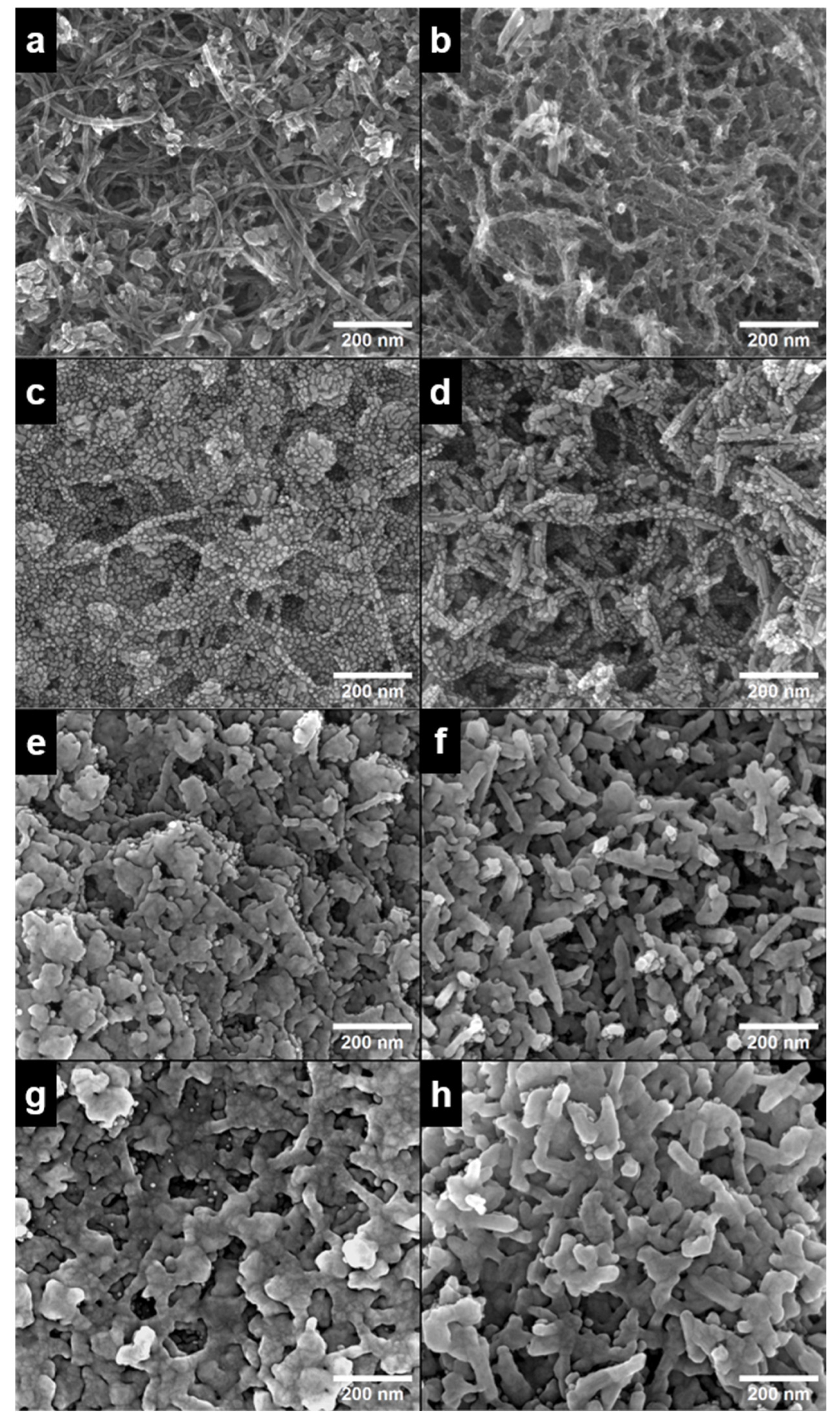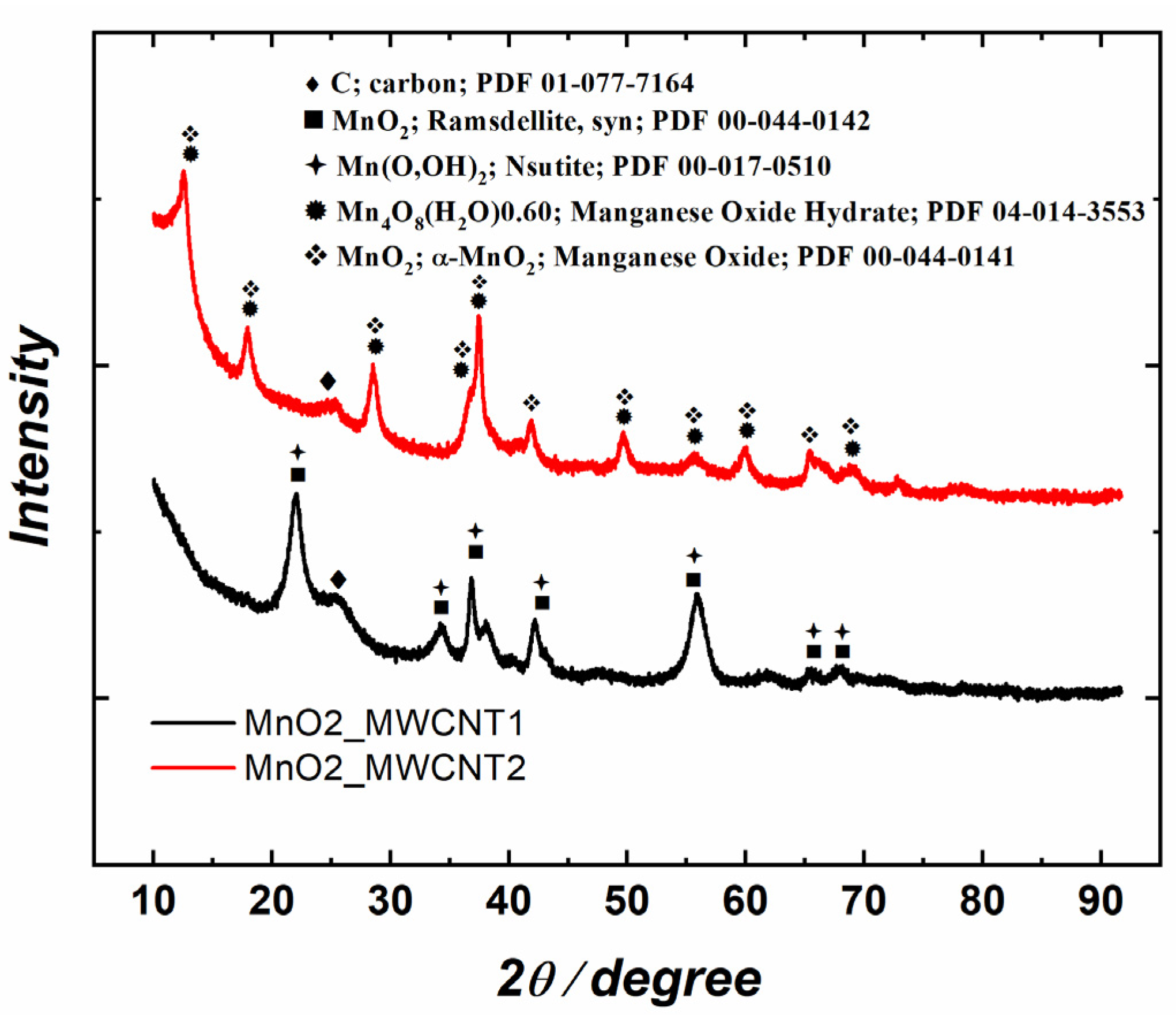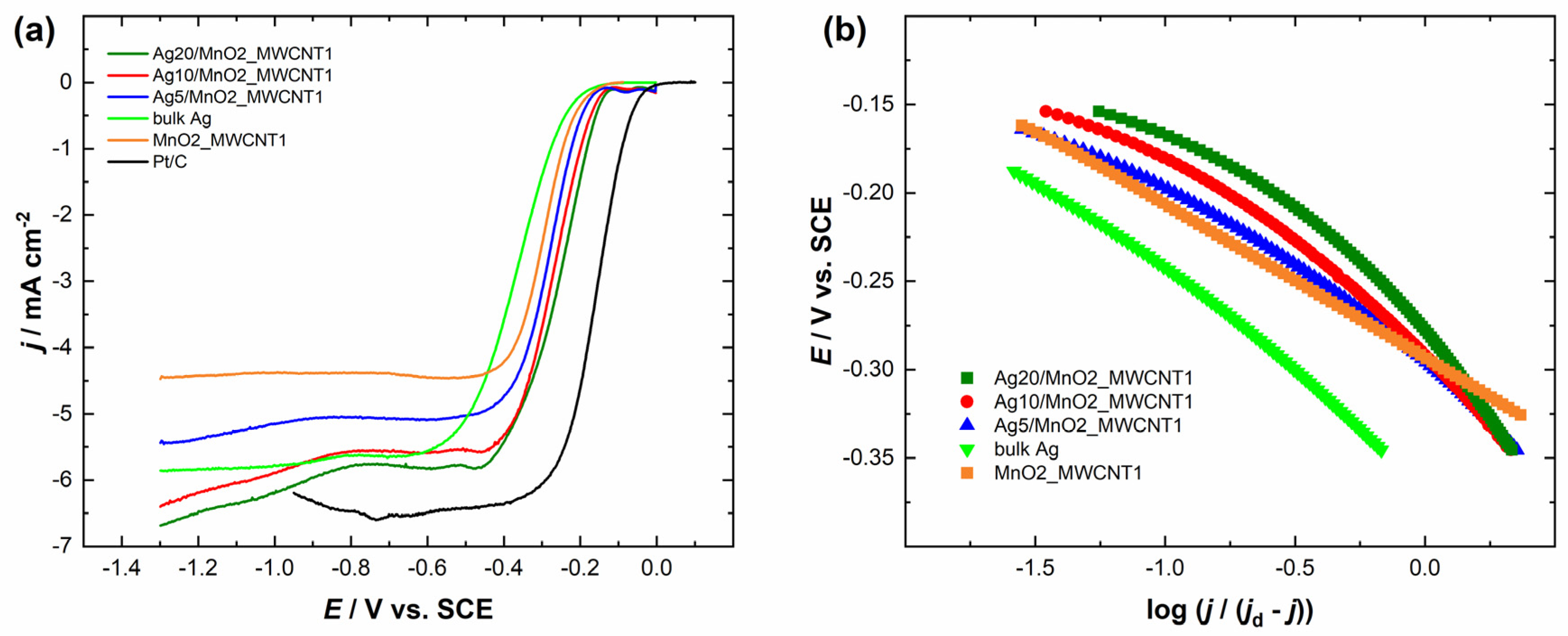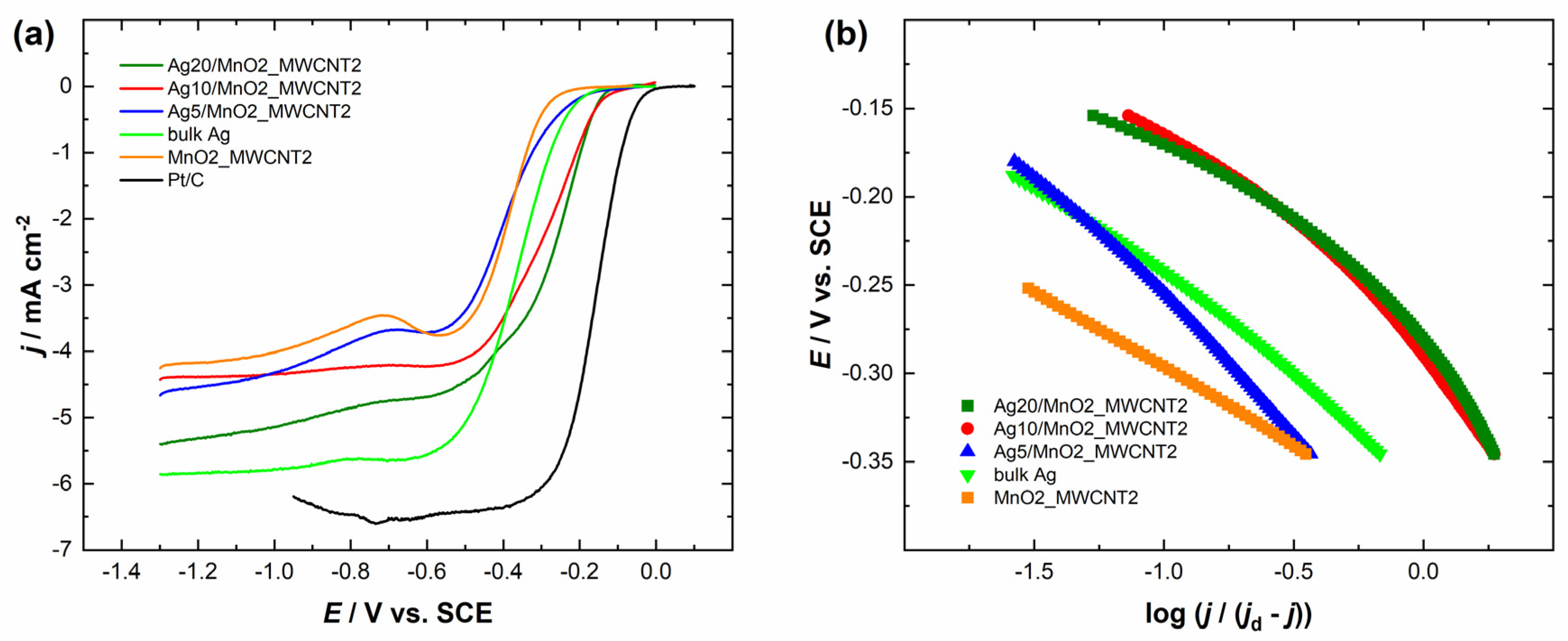Ag Sputter-Deposited on MnO2-Carbon Nanotube Nanocomposites as Electrocatalysts for Oxygen Reduction Reaction in Alkaline Media
Abstract
1. Introduction
2. Results and Discussion
2.1. Physicochemical Characterisation of Catalysts
2.2. Oxygen Reduction Reaction Studies
3. Materials and Methods
3.1. Synthesis of MnO2_MWCNT1 and MnO2_MWCNT2
3.2. Silver Deposition Using Magnetron Sputtering
3.3. Electrochemical Testing
3.4. Catalyst Characterization
4. Conclusions
Supplementary Materials
Author Contributions
Funding
Data Availability Statement
Conflicts of Interest
References
- Hussain, S.; Erikson, H.; Kongi, N.; Sarapuu, A.; Solla-Gullón, J.; Maia, G.; Kannan, A.M.; Alonso-Vante, N.; Tammeveski, K. Oxygen reduction reaction on nanostructured Pt-based electrocatalysts: A review. Int. J. Hydrogen Energy 2020, 45, 31775–31797. [Google Scholar] [CrossRef]
- Hernandez-Rodriguez, M.A.; Goya, M.C.; Arevalo, M.C.; Rodriguez, J.L.; Pastor, E. Carbon supported Ag and Ag-Co catalysts tolerant to methanol and ethanol for the oxygen reduction reaction in alkaline media. Int. J. Hydrogen Energy 2016, 41, 19789–19798. [Google Scholar] [CrossRef]
- Linge, J.M.; Erikson, H.; Mooste, M.; Piirsoo, H.M.; Kaljuvee, T.; Kikas, A.; Aruväli, J.; Kisand, V.; Tamm, A.; Kannan, A.M.; et al. Ag nanoparticles on mesoporous carbon support as cathode catalyst for anion exchange membrane fuel cell. Int. J. Hydrogen Energy 2023, 48, 11058–11070. [Google Scholar] [CrossRef]
- Sleightholme, A.E.S.; Varcoe, J.R.; Kucernak, A.R. Oxygen reduction at the silver/hydroxide-exchange membrane interface. Electrochem. Commun. 2008, 10, 151–155. [Google Scholar] [CrossRef]
- Yang, Y.; Pan, D.; Li, J.; Jonsson, M.; Jannasch, P.; Soroka, I.L. Using an ionomer as a size regulator in γ-radiation induced synthesis of Ag nanocatalysts for oxygen reduction reaction in alkaline solution. J. Colloid Interface Sci. 2023, 646, 381–390. [Google Scholar] [CrossRef]
- Campbell, F.W.; Belding, S.R.; Baron, R.; Xiao, L.; Compton, R.G. Hydrogen Peroxide Electroreduction at a Silver-Nanoparticle Array: Investigating Nanoparticle Size and Coverage Effects. J. Phys. Chem. C 2009, 113, 9053–9062. [Google Scholar] [CrossRef]
- Han, J.J.; Li, N.; Zhang, T.Y. Ag/C nanoparticles as an cathode catalyst for a zinc-air battery with a flowing alkaline electrolyte. J. Power Sources 2009, 193, 885–889. [Google Scholar] [CrossRef]
- Erikson, H.; Sarapuu, A.; Tammeveski, K. Oxygen Reduction Reaction on Silver Catalysts in Alkaline Media: A Minireview. ChemElectroChem 2019, 6, 73–86. [Google Scholar] [CrossRef]
- Šepa, D.; Vojnovíc, M.; Damjanovic, A. Oxygen reduction at silver electrodes in alkaline solutions. Electrochim. Acta 1970, 15, 1355–1366. [Google Scholar] [CrossRef]
- Chatenet, M.; Genies-Bultel, L.; Aurousseau, M.; Durand, R.; Andolfatto, F. Oxygen reduction on silver catalysts in solutions containing various concentrations of sodium hydroxide–comparison with platinum. J. Appl. Electrochem. 2002, 32, 1131–1140. [Google Scholar] [CrossRef]
- Singh, P.; Buttry, D.A. Comparison of Oxygen Reduction Reaction at Silver Nanoparticles and Polycrystalline Silver Electrodes in Alkaline Solution. J. Phys. Chem. C 2012, 116, 10656–10663. [Google Scholar] [CrossRef]
- Blizanac, B.B.; Ross, P.N.; Markovic, N.M. Oxygen reduction on silver low-index single-crystal surfaces in alkaline solution: Rotating ring Disk(Ag(hkl)) studies. J. Phys. Chem. B 2006, 110, 4735–4741. [Google Scholar] [CrossRef] [PubMed]
- Blizanac, B.B.; Ross, P.N.; Markovic, N.M. Oxygen electroreduction on Ag(111): The pH effect. Electrochim. Acta 2007, 52, 2264–2271. [Google Scholar] [CrossRef]
- Lee, C.L.; Chiou, H.P.; Syu, C.M.; Wu, C.C. Silver triangular nanoplates as electrocatalyst for oxygen reduction reaction. Electrochem. Commun. 2010, 12, 1609–1613. [Google Scholar] [CrossRef]
- Ohyama, J.; Okata, Y.; Watabe, N.; Katagiri, M.; Nakamura, A.; Arikawa, H.; Shimizu, K.; Takeguchi, T.; Ueda, W.; Satsuma, A. Oxygen reduction reaction over silver particles with various morphologies and surface chemical states. J. Power Sources 2014, 245, 998–1004. [Google Scholar] [CrossRef]
- Wang, Q.Y.; Cui, X.Q.; Guan, W.M.; Zhang, L.; Fan, X.F.; Shi, Z.; Zheng, W.T. Shape-dependent catalytic activity of oxygen reduction reaction (ORR) on silver nanodecahedra and nanocubes. J. Power Sources 2014, 269, 152–157. [Google Scholar] [CrossRef]
- Treshchalov, A.; Erikson, H.; Puust, L.; Tsarenko, S.; Saar, R.; Vanetsev, A.; Tammeveski, K.; Sildos, I. Stabilizer-free silver nanoparticles as efficient catalysts for electrochemical reduction of oxygen. J. Colloid Interface Sci. 2017, 491, 358–366. [Google Scholar] [CrossRef]
- Alia, S.M.; Duong, K.; Liu, T.; Jensen, K.; Yan, Y.S. Supportless Silver Nanowires as Oxygen Reduction Reaction Catalysts for Hydroxide-Exchange Membrane Fuel Cells. ChemSusChem 2012, 5, 1619–1624. [Google Scholar] [CrossRef]
- Lu, Y.Z.; Chen, W. Size effect of silver nanoclusters on their catalytic activity for oxygen electro-reduction. J. Power Sources 2012, 197, 107–110. [Google Scholar] [CrossRef]
- Tammeveski, K.; Kontturi, K.; Nichols, R.J.; Potter, R.J.; Schiffrin, D.J. Surface redox catalysis for O-2 reduction on quinone-modified glassy carbon electrodes. J. Electroanal. Chem. 2001, 515, 101–112. [Google Scholar] [CrossRef]
- Kruusenberg, I.; Leis, J.; Arulepp, M.; Tammeveski, K. Oxygen reduction on carbon nanomaterial-modified glassy carbon electrodes in alkaline solution. J. Solid State Electrochem. 2010, 14, 1269–1277. [Google Scholar] [CrossRef]
- Guo, J.S.; Hsu, A.; Chu, D.; Chen, R.R. Improving Oxygen Reduction Reaction Activities on Carbon-Supported Ag Nanoparticles in Alkaline Solutions. J. Phys. Chem. C 2010, 114, 4324–4330. [Google Scholar] [CrossRef]
- Wang, Z.C.; Xin, L.; Zhao, X.S.; Qiu, Y.; Zhang, Z.Y.; Baturina, O.A.; Li, W.Z. Carbon supported Ag nanoparticles with different particle size as cathode catalysts for anion exchange membrane direct glycerol fuel cells. Renew. Energy 2014, 62, 556–562. [Google Scholar] [CrossRef]
- Zhang, Z.W.; Li, H.N.; Hu, J.; Liu, B.Z.; Zhang, Q.R.; Fernandez, C.; Peng, Q.M. High oxygen reduction reaction activity of C-N/Ag hybrid composites for Zn-air battery. J. Alloys Compd. 2017, 694, 419–428. [Google Scholar] [CrossRef]
- Tammeveski, L.; Erikson, H.; Sarapuu, A.; Kozlova, J.; Ritslaid, P.; Sammelselg, V.; Tammeveski, K. Electrocatalytic oxygen reduction on silver nanoparticle/multi-walled carbon nanotube modified glassy carbon electrodes in alkaline solution. Electrochem. Commun. 2012, 20, 15–18. [Google Scholar] [CrossRef]
- Fazil, A.; Chetty, R. Synthesis and Evaluation of Carbon Nanotubes Supported Silver Catalyst for Alkaline Fuel Cell. Electroanalysis 2014, 26, 2380–2387. [Google Scholar] [CrossRef]
- Linge, J.M.; Erikson, H.; Sarapuu, A.; Merisalu, M.; Rahn, M.; Matisen, L.; Sammelselg, V.; Tammeveski, K. Electroreduction of oxygen on nitrogen-doped graphene oxide supported silver nanoparticles. J. Electroanal. Chem. 2017, 794, 197–203. [Google Scholar] [CrossRef]
- Panomsuwan, G.; Chantaramethakul, J.; Chokradjaroen, C.; Ishizaki, T. In situ solution plasma synthesis of silver nanoparticles supported on nitrogen-doped carbons with enhanced oxygen reduction activity. Mater. Lett. 2019, 251, 135–139. [Google Scholar] [CrossRef]
- Li, Z.; Zhang, J.; Lin, L.; Luo, S.; Meng, A.; Song, G.; Li, S. Carbon nanotubes-supported Ag/MoO2 or Ag/MnO2 heterostructures for a highly efficient oxygen reduction reaction. Mater. Charact. 2021, 176, 111147. [Google Scholar] [CrossRef]
- Ni, S.; Zhang, H.; Zhao, Y.; Li, X.; Sun, Y.; Qian, J.; Xu, Q.; Gao, P.; Wu, D.; Kato, K.; et al. Single atomic Ag enhances the bifunctional activity and cycling stability of MnO2. Chem. Eng. J. 2019, 366, 631–638. [Google Scholar] [CrossRef]
- Wang, L.; Kong, D.; Chen, F.; Cui, L.; Cai, Y.; Wang, H.; Zhong, X.; Huang, Y.; Li, Q.; Ma, Z.; et al. Strongly Coupled MnO2 Nanosheets/Silver Nanoparticles Hierarchical Spheres for Efficient Oxygen Reduction Reaction Electrocatalysis. Energy Fuels 2021, 35, 16829–16836. [Google Scholar] [CrossRef]
- Sun, H.; Hu, Z.; Yao, C.; Yu, J.; Du, Z. Silver Doped Amorphous MnO2 as Electrocatalysts for Oxygen Reduction Reaction in Al-Air Battery. J. Electrochem. Soc. 2020, 167, 080539. [Google Scholar] [CrossRef]
- Zamora Zeledón, J.A.; Gunasooriya, G.T.K.K.; Kamat, G.A.; Kreider, M.E.; Ben-Naim, M.; Hubert, M.A.; Avilés Acosta, J.E.; Nørskov, J.K.; Stevens, M.B.; Jaramillo, T.F. Engineering metal–metal oxide surfaces for high-performance oxygen reduction on Ag–Mn electrocatalysts. Energy Environ. Sci. 2022, 15, 1611–1629. [Google Scholar] [CrossRef]
- Liu, J.; Liu, J.; Song, W.; Wang, F.; Song, Y. The role of electronic interaction in the use of Ag and Mn3O4 hybrid nanocrystals covalently coupled with carbon as advanced oxygen reduction electrocatalysts. J. Mater. Chem. A 2014, 2, 17477–17488. [Google Scholar] [CrossRef]
- Slanac, D.A.; Lie, A.; Paulson, J.A.; Stevenson, K.J.; Johnston, K.P. Bifunctional Catalysts for Alkaline Oxygen Reduction Reaction via Promotion of Ligand and Ensemble Effects at Ag/MnOx Nanodomains. J. Phys. Chem. C 2012, 116, 11032–11039. [Google Scholar] [CrossRef]
- Akbarian, P.; Kheirmand, M.; Faraji, M. Facile electrochemical fabrication of high-performance graphene quantum dots-supported Mn3O4/Ag hybrid catalyst for oxygen reduction reaction in alkaline media. Int. J. Energy Res. 2022, 46, 23004–23019. [Google Scholar] [CrossRef]
- Xu, H.; Qu, Z.; Zhao, S.; Mei, J.; Quan, F.; Yan, N. Different crystal-forms of one-dimensional MnO2 nanomaterials for the catalytic oxidation and adsorption of elemental mercury. J. Hazard. Mater. 2015, 299, 86–93. [Google Scholar] [CrossRef]
- Yang, J.; Wang, J.; Ma, S.; Ke, B.; Yu, L.; Zeng, W.; Li, Y.; Wang, J. Insight into the effect of crystalline structure on the oxygen reduction reaction activities of one-dimensional MnO2. Phys. E Low-Dimens. Syst. Nanostructures 2019, 109, 191–197. [Google Scholar] [CrossRef]
- Cao, Y.L.; Yang, H.X.; Ai, X.P.; Xiao, L.F. The mechanism of oxygen reduction on MnO2-catalyzed air cathode in alkaline solution. J. Electroanal. Chem. 2003, 557, 127–134. [Google Scholar] [CrossRef]
- Yang, Z.; Zhou, X.; Nie, H.; Yao, Z.; Huang, S. Facile Construction of Manganese Oxide Doped Carbon Nanotube Catalysts with High Activity for Oxygen Reduction Reaction and Investigations into the Origin of their Activity Enhancement. ACS Appl. Mater. Interfaces 2011, 3, 2601–2606. [Google Scholar] [CrossRef]
- Hussain, S.; Erikson, H.; Kongi, N.; Merisalu, M.; Ritslaid, P.; Sammelselg, V.; Tammeveski, K. Heat-treatment effects on the ORR activity of Pt nanoparticles deposited on multi-walled carbon nanotubes using magnetron sputtering technique. Int. J. Hydrogen Energy 2017, 42, 5958–5970. [Google Scholar] [CrossRef]
- Jukk, K.; Kozlova, J.; Ritslaid, P.; Sammelselg, V.; Alexeyeva, N.; Tammeveski, K. Sputter-deposited Pt nanoparticle/multi-walled carbon nanotube composite catalyst for oxygen reduction reaction. J. Electroanal. Chem. 2013, 708, 31–38. [Google Scholar] [CrossRef]
- Jukk, K.; Alexeyeva, N.; Ritslaid, P.; Kozlova, J.; Sammelselg, V.; Tammeveski, K. Electrochemical Reduction of Oxygen on Heat-Treated Pd Nanoparticle/Multi-Walled Carbon Nanotube Composites in Alkaline Solution. Electrocatalysis 2013, 4, 42–48. [Google Scholar] [CrossRef]
- Alexeyeva, N.; Kozlova, J.; Sammelselg, V.; Ritslaid, P.; Mandar, H.; Tammeveski, K. Electrochemical and surface characterisation of gold nanoparticle decorated multi-walled carbon nanotubes. Appl. Surf. Sci. 2010, 256, 3040–3046. [Google Scholar] [CrossRef]
- Hussain, S.; Erikson, H.; Kongi, N.; Tarre, A.; Ritslaid, P.; Kook, M.; Rahn, M.; Merisalu, M.; Sammelselg, V.; Tammeveski, K. Improved ORR Activity and Long-Term Durability of Pt Nanoparticles Deposited on TiO2-Decorated Multiwall Carbon Nanotubes. J. Electrochem. Soc. 2019, 166, F1284–F1291. [Google Scholar] [CrossRef]
- Hussain, S.; Erikson, H.; Kongi, N.; Tarre, A.; Ritslaid, P.; Rahn, M.; Matisen, L.; Merisalu, M.; Sammelselg, V.; Tammeveski, K. Pt nanoparticles sputter-deposited on TiO2/MWCNT composites prepared by atomic layer deposition: Improved electrocatalytic activity towards the oxygen reduction reaction and durability in acid media. Int. J. Hydrogen Energy 2018, 43, 4967–4977. [Google Scholar] [CrossRef]
- Jukk, K.; Kongi, N.; Tarre, A.; Rosental, A.; Treshchalov, A.B.; Kozlova, J.; Ritslaid, P.; Matisen, L.; Sammelselg, V.; Tammeveski, K. Electrochemical oxygen reduction behaviour of platinum nanoparticles supported on multi-walled carbon nanotube/titanium dioxide composites. J. Electroanal. Chem. 2014, 735, 68–76. [Google Scholar] [CrossRef]
- Wang, J.-G.; Yang, Y.; Huang, Z.-H.; Kang, F. Rational synthesis of MnO2/conducting polypyrrole@carbon nanofiber triaxial nano-cables for high-performance supercapacitors. J. Mater. Chem. 2012, 22, 16943–16949. [Google Scholar] [CrossRef]
- Lee, S.W.; Kim, J.; Chen, S.; Hammond, P.T.; Shao-Horn, Y. Carbon Nanotube/Manganese Oxide Ultrathin Film Electrodes for Electrochemical Capacitors. ACS Nano 2010, 4, 3889–3896. [Google Scholar] [CrossRef]
- Li, Q.; Liu, J.; Zou, J.; Chunder, A.; Chen, Y.; Zhai, L. Synthesis and electrochemical performance of multi-walled carbon nanotube/polyaniline/MnO2 ternary coaxial nanostructures for supercapacitors. J. Power Sources 2011, 196, 565–572. [Google Scholar] [CrossRef]
- Davis, R.E.; Horvath, G.L.; Tobias, C.W. The solubility and diffusion coefficient of oxygen in potassium hydroxide solutions. Electrochim. Acta 1967, 12, 287–297. [Google Scholar] [CrossRef]
- Lide, D.R. CRC Handbook of Chemistry and Physics, 82nd ed.; CRC Press: Boca Raton, FL, USA, 2001. [Google Scholar]
- Linge, J.M.; Kozhemyakin, D.; Erikson, H.; Vlassov, S.; Kongi, N.; Tammeveski, K. Silver Nanowire-Based Catalysts for Oxygen Reduction Reaction in Alkaline Solution. ChemCatChem 2021, 13, 4364–4371. [Google Scholar] [CrossRef]
- Linge, J.M.; Erikson, H.; Merisalu, M.; Matisen, L.; Kaarik, M.; Leis, J.; Sammelselg, V.; Aruvali, J.; Kaljuvee, T.; Tammeveski, K. Oxygen Reduction on Silver Nanoparticles Supported on Carbide-Derived Carbons. J. Electrochem. Soc. 2018, 165, F1199–F1205. [Google Scholar] [CrossRef]
- Linge, J.M.; Erikson, H.; Merisalu, M.; Sammelselg, V.; Tammeveski, K. Oxygen reduction on silver catalysts electrodeposited on various nanocarbon supports. SN Appl. Sci. 2021, 3, 263. [Google Scholar] [CrossRef]
- Salome, S.; Rego, R.; Oliveira, M.C. Development of silver-gas diffusion electrodes for the oxygen reduction reaction by electrodeposition. Mater. Chem. Phys. 2013, 143, 109–115. [Google Scholar] [CrossRef]
- Linge, J.M.; Erikson, H.; Kasikov, A.; Rahn, M.; Sammelselg, V.; Tammeveski, K. Oxygen reduction reaction on thin-film Ag electrodes in alkaline solution. Electrochim. Acta 2019, 325, 134922. [Google Scholar] [CrossRef]
- Linge, J.M.; Erikson, H.; Kozlova, J.; Sammelselg, V.; Tammeveski, K. Oxygen reduction reaction on electrochemically deposited silver nanoparticles from non-aqueous solution. J. Electroanal. Chem. 2018, 810, 129–134. [Google Scholar] [CrossRef]
- Linge, J.M.; Erikson, H.; Kozlova, J.; Aruvali, J.; Sammelselg, V.; Tammeveski, K. Oxygen reduction on electrodeposited silver catalysts in alkaline solution. J. Solid State Electrochem. 2018, 22, 81–89. [Google Scholar] [CrossRef]
- Hu, F.-P.; Zhang, X.-G.; Xiao, F.; Zhang, J.-L. Oxygen reduction on Ag–MnO2/SWNT and Ag–MnO2/AB electrodes. Carbon 2005, 43, 2931–2936. [Google Scholar] [CrossRef]
- Wolf, S.; Roschger, M.; Genorio, B.; Kolar, M.; Garstenauer, D.; Bitschnau, B.; Hacker, V. Ag-MnxOy on Graphene Oxide Derivatives as Oxygen Reduction Reaction Catalyst in Alkaline Direct Ethanol Fuel Cells. Catalysts 2022, 12, 780. [Google Scholar] [CrossRef]
- Innocenti, M.; Zafferoni, C.; Lavacchi, A.; Becucci, L.; Di Benedetto, F.; Carretti, E.; Vizza, F.; Foresti, M.L. Electroactivation of Microparticles of Silver on Glassy Carbon for Oxygen Reduction and Oxidation Reactions. J. Electrochem. Soc. 2014, 161, D3018–D3024. [Google Scholar] [CrossRef]
- Lai, C.; Kolla, P.; Zhao, Y.; Fong, H.; Smirnova, A.L. Lignin-derived electrospun carbon nanofiber mats with supercritically deposited Ag nanoparticles for oxygen reduction reaction in alkaline fuel cells. Electrochim. Acta 2014, 130, 431–438. [Google Scholar] [CrossRef]
- He, M.; Turup, Z.; Jin, X.; Chen, F. Ag nanoparticle-loaded to MnO2 with rich oxygen vacancies and Mn3+ for the synergistically enhanced oxygen reduction reaction. Int. J. Hydrogen Energy 2023, in press. [CrossRef]
- Wiberg, G.K.H.; Mayrhofer, K.J.J.; Arenz, M. Investigation of the Oxygen Reduction Activity on Silver—A Rotating Disc Electrode Study. Fuel Cells 2010, 10, 575–581. [Google Scholar] [CrossRef]
- Wiberg, G.; Mayrhofer, K.; Arenz, M. Investigation of the Oxygen Reduction Activity of non-Platinum Catalysts—A RDE Methodology. ECS Trans. 2009, 19, 37–46. [Google Scholar] [CrossRef]
- Chao, Y.J.; Lyu, Y.P.; Wu, Z.W.; Lee, C.L. Seed-mediated growth of Ag nanocubes and their size-dependent activities toward oxygen reduction reaction. Int. J. Hydrogen Energy 2016, 41, 3896–3903. [Google Scholar] [CrossRef]
- Zhou, R.F.; Qiao, S.Z. Silver/Nitrogen-Doped Graphene Interaction and Its Effect on Electrocatalytic Oxygen Reduction. Chem. Mater. 2014, 26, 5868–5873. [Google Scholar] [CrossRef]
- Alexeyeva, N.; Tammeveski, K. Electrochemical reduction of oxygen on multiwalled carbon nanotube modified glassy carbon electrodes in acid media. Electrochem. Solid State Lett. 2007, 10, F18–F21. [Google Scholar] [CrossRef]
- Roy, A.; Ray, A.; Saha, S.; Ghosh, M.; Das, T.; Nandi, M.; Lal, G.; Das, S. Influence of electrochemical active surface area on the oxygen evolution reaction and energy storage performance of MnO2-multiwalled carbon nanotube composite. Int. J. Energy Res. 2021, 45, 16908–16921. [Google Scholar] [CrossRef]
- Chen, Y.; Zhang, Y.; Geng, D.; Li, R.; Hong, H.; Chen, J.; Sun, X. One-pot synthesis of MnO2/graphene/carbon nanotube hybrid by chemical method. Carbon 2011, 49, 4434–4442. [Google Scholar] [CrossRef]






| Catalyst | Ag/wt% | Mn/wt% | C/wt% |
|---|---|---|---|
| Ag20/MnO2_MWCNT1 | 10 ± 1 | 38 ± 3 | 27 ± 4 |
| Ag20/MnO2_MWCNT2 | 10 ± 1 | 42 ± 12 | 16 ± 2 |
| Ag10/MnO2_MWCNT1 | 5 ± 1 | 34 ± 4 | 34 ± 4 |
| Ag10/MnO2_MWCNT2 | 6 ± 1 | 49 ± 6 | 11 ± 2 |
| Ag5/MnO2_MWCNT1 | 1.5 ± 0.1 | 37 ± 5 | 30 ± 4 |
| Ag5/MnO2_MWCNT2 | 1.5 ± 0.2 | 51 ± 4 | 11 ± 2 |
| Catalyst | E1/2/V vs. SCE | ∆E1/2 after AST/mV | MA (−0.2 V vs. SCE)/A g−1 | Tafel Slope/mV |
|---|---|---|---|---|
| Ag20/MnO2_MWCNT1 | −0.29 | 40 | 88 | −85 |
| Ag20/MnO2_MWCNT2 | −0.29 | 56 | 61 | −82 |
| Ag10/MnO2_MWCNT1 | −0.30 | 4 | 124 | −81 |
| Ag10/MnO2_MWCNT2 | −0.32 | 24 | 110 | −93 |
| Ag5/MnO2_MWCNT1 | −0.30 | 2 | 126 | −81 |
| Ag5/MnO2_MWCNT2 | −0.43 | 28 | 35 | −94 |
| Ag bulk | −0.37 | n/a | n/a | −80 |
| MnO2_MWCNT1 | −0.31 | n/a | n/a | −86 |
| MnO2_MWCNT2 | −0.41 | n/a | n/a | −117 |
| Pt/C | −0.16 | n/a | n/a | n/a |
Disclaimer/Publisher’s Note: The statements, opinions and data contained in all publications are solely those of the individual author(s) and contributor(s) and not of MDPI and/or the editor(s). MDPI and/or the editor(s) disclaim responsibility for any injury to people or property resulting from any ideas, methods, instructions or products referred to in the content. |
© 2023 by the authors. Licensee MDPI, Basel, Switzerland. This article is an open access article distributed under the terms and conditions of the Creative Commons Attribution (CC BY) license (https://creativecommons.org/licenses/by/4.0/).
Share and Cite
Linge, J.M.; Erikson, H.; Ritslaid, P.; Kikas, A.; Kisand, V.; Aruväli, J.; Kozlova, J.; Tamm, A.; Sarapuu, A.; Tammeveski, K. Ag Sputter-Deposited on MnO2-Carbon Nanotube Nanocomposites as Electrocatalysts for Oxygen Reduction Reaction in Alkaline Media. Catalysts 2023, 13, 976. https://doi.org/10.3390/catal13060976
Linge JM, Erikson H, Ritslaid P, Kikas A, Kisand V, Aruväli J, Kozlova J, Tamm A, Sarapuu A, Tammeveski K. Ag Sputter-Deposited on MnO2-Carbon Nanotube Nanocomposites as Electrocatalysts for Oxygen Reduction Reaction in Alkaline Media. Catalysts. 2023; 13(6):976. https://doi.org/10.3390/catal13060976
Chicago/Turabian StyleLinge, Jonas Mart, Heiki Erikson, Peeter Ritslaid, Arvo Kikas, Vambola Kisand, Jaan Aruväli, Jekaterina Kozlova, Aile Tamm, Ave Sarapuu, and Kaido Tammeveski. 2023. "Ag Sputter-Deposited on MnO2-Carbon Nanotube Nanocomposites as Electrocatalysts for Oxygen Reduction Reaction in Alkaline Media" Catalysts 13, no. 6: 976. https://doi.org/10.3390/catal13060976
APA StyleLinge, J. M., Erikson, H., Ritslaid, P., Kikas, A., Kisand, V., Aruväli, J., Kozlova, J., Tamm, A., Sarapuu, A., & Tammeveski, K. (2023). Ag Sputter-Deposited on MnO2-Carbon Nanotube Nanocomposites as Electrocatalysts for Oxygen Reduction Reaction in Alkaline Media. Catalysts, 13(6), 976. https://doi.org/10.3390/catal13060976







